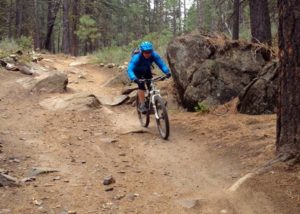
Mt. Biking Tips to Keep You Riding
written by Lindsay Lund, PT, DPT, CMPT
Central Oregon is a phenomenal region to explore on a mountain bike. We have an expansive trail network, fantastic weather, and a large cycling community that is excited to adventure with other riders. While this sport is incredible, there is the risk of injury just like there is when participating in other sports. This risk of injury is present regardless of if you are a novice vs. expert rider or seek cross country trails vs. downhill trails.
In the clinic, I most often see people following a traumatic injury. These injuries typically include a broken collar bone, broken shoulder, and/or dislocated shoulder. An injury like this will often require a consult with an orthopedic surgeon to determine if surgery is necessary. Eventually, the cyclist will need to be treated by a physical therapist (PT) who will use a combination of hands-on  techniques (stretches, massage, joint mobilizations), exercises, and modalities (ice, heat, etc…) to restore the patient’s function and improve pain. If a rider doesn’t attend PT following these injuries, there is concern they won’t return to their desired level of performance, will have persistent pain, and could be at risk of developing other overuse injuries as they compensate for residual impairments in mobility, strength, and posture.
techniques (stretches, massage, joint mobilizations), exercises, and modalities (ice, heat, etc…) to restore the patient’s function and improve pain. If a rider doesn’t attend PT following these injuries, there is concern they won’t return to their desired level of performance, will have persistent pain, and could be at risk of developing other overuse injuries as they compensate for residual impairments in mobility, strength, and posture.
Overuse injuries aren’t always a result of poor rehab after an acute injury. Cycling is a very repetitive sport and can be painful when someone doesn’t move in an optimal manner. Low back pain is a common complaint I hear amongst cyclist. A weak core and gluteal muscles can place more stress on the low back during riding and contribute to pain. To improve these weaknesses, specific exercises targeting those muscles need to be completed off the bike.
 Stiffness in the hips and upper back can also contribute to low back pain because they place the low back in a rounded position. Consistent exercise, focused on improving the strength and mobility of the upper back and the hips, can reduce strain on the low back while cycling. There are numerous strengthening and stretching exercises that can ease low back pain, but I recommend getting evaluated by a PT so you can have a program tailored to your needs and ensure you complete the exercises correctly and safely.
Stiffness in the hips and upper back can also contribute to low back pain because they place the low back in a rounded position. Consistent exercise, focused on improving the strength and mobility of the upper back and the hips, can reduce strain on the low back while cycling. There are numerous strengthening and stretching exercises that can ease low back pain, but I recommend getting evaluated by a PT so you can have a program tailored to your needs and ensure you complete the exercises correctly and safely.
If you’re uncomfortable riding or have just sustained an acute injury, give one of our clinics a call. After a comprehensive evaluation to find the cause of your pain, we will guide you through a treatment plan so you can return to riding with more comfort.
